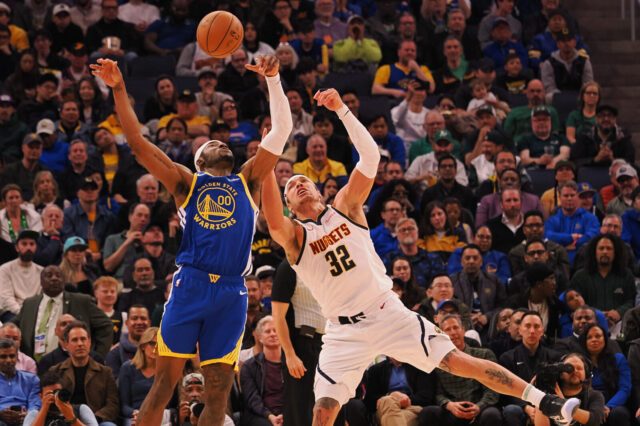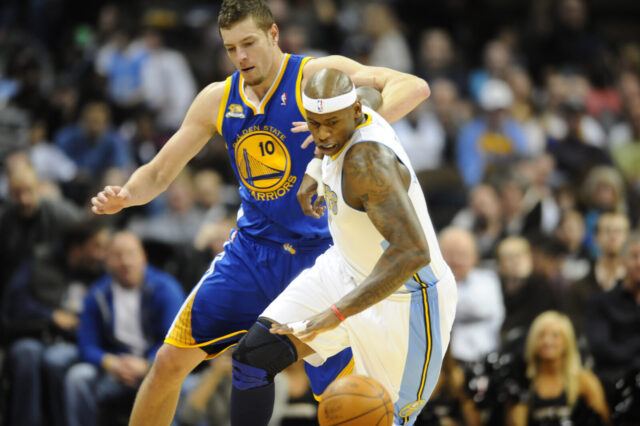There’s been a lot of discussion around the idea of playing Michael Porter Jr. and Paul Millsap together of late. Some of that has been prompted by me of course. It’s difficult to foresee that duo being impactful in a playoff series for the Nuggets on the floor at the same time for a number of reasons, and the most important reason why is reliability.
In 258 minutes of playing time, the Porter-Millsap has been outscored by two points. That may not seem like a lot, but it’s Michael Porter Jr.’s worst plus-minus duo on the team (greater than 100 minutes played together). Next closest is Harris-Porter at plus-24. The best Porter duo? The Nuggets are plus-168 in the 556 minutes Porter and Jamal Murray have played together, a good sign for things to come.
Back to Porter and Millsap. When the two play together, the Nuggets have no problems scoring offensively. Their 121.0 offensive rating should be illegal in several countries. Unfortunately, the 120.2 defensive rating should also be illegal. The Nuggets haven’t been able to figure out how to defend with Porter and Millsap on the floor together, and the majority of the reason is they’ve played too big to keep up on the perimeter.
Let’s talk about the lineup.
Vulnerable to small wings and floor spacing power forwards
Michael Porter Jr. has struggled with defense for the majority of his NBA career. Though he has made significant strides, there are still weaknesses in his game that defenses attempt to exploit whenever they can: namely is inability to stick with perimeter shooters.
In the play above, the Memphis Grizzlies use a set that the Utah Jazz used against Porter countless times in the Bubble playoffs called HORNS Twist. The goal of the play: cause chaos in the middle of the floor by screening for the screener to free up an open three. If that doesn’t work, simply flow into a middle pick and roll.
Porter learned to navigate it by the end of that series, and it’s one of the reasons Denver advanced at all, but when he isn’t keyed in on certain sets and certain actions, the second year forward often lags behind the perimeter shooter.
Fortunately for Porter, he has the athleticism and length to make up for some of the deficiencies in recognizing the play. The same cannot be said for Paul Millsap, who just turned 36 in February and hasn’t been the same level of defensive player he was in previous years. There are a variety of minor reasons why Millsap has struggled defensively this year, but the primary concern has to be perimeter defense. In the modern NBA, power forwards are asked to cover a lot of ground, something Millsap just isn’t able to do at this stage in his career.
Opposing players have shot 49.1% from three-point range with Millsap as the primary defender this season, according to NBA.com. That is tied for the highest percentage allowed in the NBA among players to appear in at least 25 games. It’s easy to see why teams are shooting a high percentage too: they don’t fear Millsap’s closeouts on the perimeter.
The possession above is a problem. The pass from De’Anthony Melton to Brandon Clarke is looping, caught outside the shooting pocket, and the momentum of the pass takes Clarke away from the basket. Millsap should be able to close out to Clarke here and offer a better contest. Either he doesn’t because of poor footwork/recognition, or he physically can’t get out there. The fear is that it’s the latter, because if that’s the case, there’s nothing Denver can ultimately do to solve this problem.
Crowding the paint offensively
It doesn’t happen as often as it used to because the Nuggets are relearning how to properly space the floor around Nikola Jokić, but there are often times where Michael Porter Jr. and Paul Millsap over cut or simply cut at the wrong time and make things infinitely more difficult.
There is so much value in having a player in the dunker spot frequently, especially when it’s Jokić who’s reading the floor and making plays. Unfortunately, when teams cover the pick and roll well as the Oklahoma City Thunder do above, the time to sit under the rim is definitely over. Murray and Jokić generate a switch right under the rim with Luguentz Dort failing to stifle Jokić. What Jokić doesn’t sense is Paul Millsap creeping under the rim as well with Darius Bazley placed firmly in between Jokić and the rim.
Sometimes, this happens. Jokić is supposed to go up with that shot. Millsap is either supposed to go to the corner or crash the glass, and he chooses to get on the boards. It’s tough, because if Jokić gets a shot on the rim, Millsap is in great rebounding position to follow up. Still, it’s a minor issue but an issue nonetheless.
Porter can also over cut too. Even when teams are sitting on the back cut, Porter likes to hunt for the backdoor pass and the dunk he often gets with Jokić on the floor. Millsap goes to set a pin down screen, one I’d honestly believe he would have slipped had Porter not cut already. It’s never a bad thing to cut and move off ball, but doing it too much prevents the Nuggets from running offense and keeping opposing defenses honest. As big bodies, Porter and Millsap often generate a lot of attention around the rim. That doesn’t help the driving lanes for Jokić, Jamal Murray, Will Barton, and other Nuggets ball handlers though.
The primary reason this concerns me: transition defense. When the Nuggets have three players that want to hang around the basket, quick scores the other way, especially transition threes, are a scary proposition.
Something to monitor.
Playing with and without Nikola Jokić
Against the Indiana Pacers on Monday night, the Nuggets had a plus-minus of minus-1 with Porter, Millsap, and Jokić all sharing the floor together. The Nuggets were plus-16 in all other minutes played, including a roughly four minute stretch in the fourth quarter that saw Porter at power forward and Millsap at center. That period saw Denver go plus-10, and it was interesting to see how Denver’s frontcourt responsibilities changed in those minutes.
When Millsap was taken to the post by Domantas Sabonis, a two-time All-Star center, the Nuggets remained in great position because of Millsap’s solid 1-on-1 coverage and Porter’s help defense.
Even when Porter was stuck guarding a wing, he was okay because of the personnel around him. Millsap played coverage on the roll man excellently, Campazzo and Barton shrunk the floor, and Dozier stepped up to take a charge from the weak side and caused Caris LeVert to pull up for a low quality shot.
Porter and Millsap weren’t stuck chasing off-ball wings around the perimeter in this configuration. They were put in what I’d consider more natural defensive positions for each of them at this time, with Millsap close to basket and Porter often floating around the weak side and baseline area.
It’s a distinct difference from what happens when Jokić is on the floor. Responsibilities change entirely if that’s the case, with Jokić being the primary pick and roll big defensively, Millsap floating around the weak side and baseline, and Porter chasing around wings on the perimeter. That puts all three players in a tough spot frankly.
Do what you’re good at
After the win against the Pacers, Michael Malone was asked about the various factors in a Porter-Millsap lineup and what Malone had noticed. He noted that Denver had to find ways to be more comfortable playing with two bigs, given the landscape of the West and how sometimes that will need to be how Denver wins games.
Right now, the Nuggets are only good at playing with one big on the floor. Sometimes, they can get away with two bigs, but their best lineups have mostly been with Porter at the power forward spot or Porter not on the floor at all. Moving Porter up to small forward to face wings hasn’t been as successful, nor has been the combination of him and Millsap and Jokić all at once, as has been noted.
There’s definitely some logic in exploring all avenues, especially at this point in the season prior to the NBA Trade Deadline. The Nuggets are doing their best to find what they’re really good at. That way, they can double down on those strategies as the season goes on and attempt to iron out their weaknesses. As an example, the Milwaukee Bucks have struggled through switching defense all regular season with the end goal to become more versatile when the playoffs roll around. The Nuggets are hoping to do the same thing; if they can learn to excel in lineups with Porter, Millsap, and Jokić on the floor, then it adds to what they’re already good at and what they’ve shown can be relied upon.
As they continue to try things, they are gathering data, information, and experience for the hope of putting it to the best use in the playoffs. Making sure they know exactly how certain lineups will react to different situations is very important for Denver’s big picture focus.
Planning for the future
As the Nuggets continue to learn how to build around Jokić, Murray, and Porter, they must learn whether they can add a starting power forward to the fold and if Porter can handle the change. Based on the evidence we have this season, it’s very possible that the answer is no. Denver’s best looks lately have come with Porter sliding to power forward and either replacing Millsap or playing next to Millsap as the solitary big man.
But if Denver finds out they can reasonably add another power forward of the future and be successful doing so, that’s a big win. There are many more power forwards consistently available than true small forwards, which are the scarcest position group in the NBA. Names like Aaron Gordon, John Collins, and Julius Randle have flown around the periphery of the elite bigs because of various deficiencies in the modern NBA, but they really are the last line of non-floor spacing, non-Zion Williamson category of power forwards today (yes, they can all shoot to varying levels, but that’s not their game).
Long term, the Nuggets know if they are looking for that type of player next to Porter at the other forward spot. Are they looking for someone more mobile? Are the looking for a true floor spacer? Would they rather have a bit of a bruiser in these games at least to start things off? Would they rather just add a true wing and move Porter to power forward anyway?
There are a lot of reasonable questions to be asked, and the Porter-Millsap pairing is helping to answer some of them. At least, in a way. It may not be Denver’s most ideal unit, but it does help Denver discover more things about their roster along the way,


